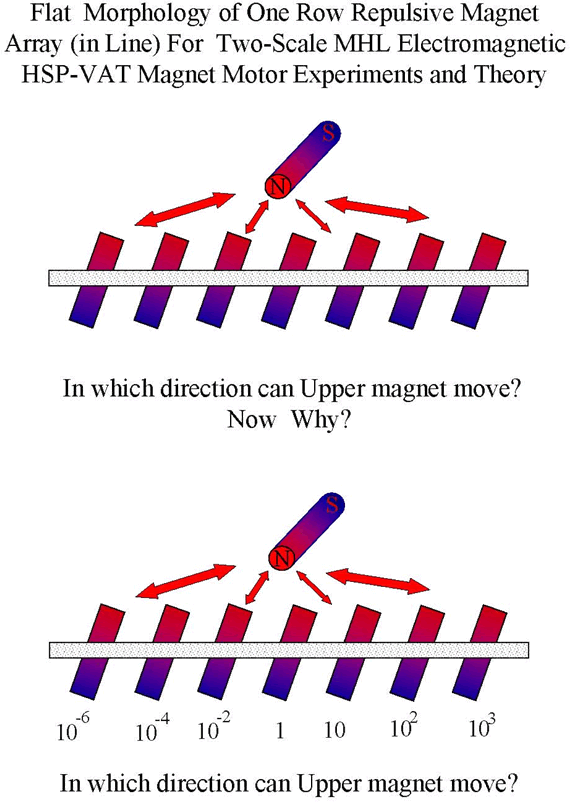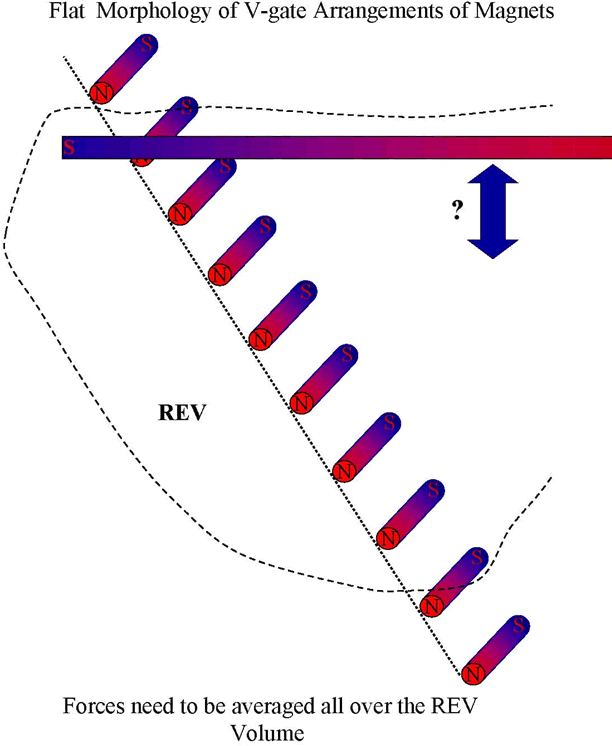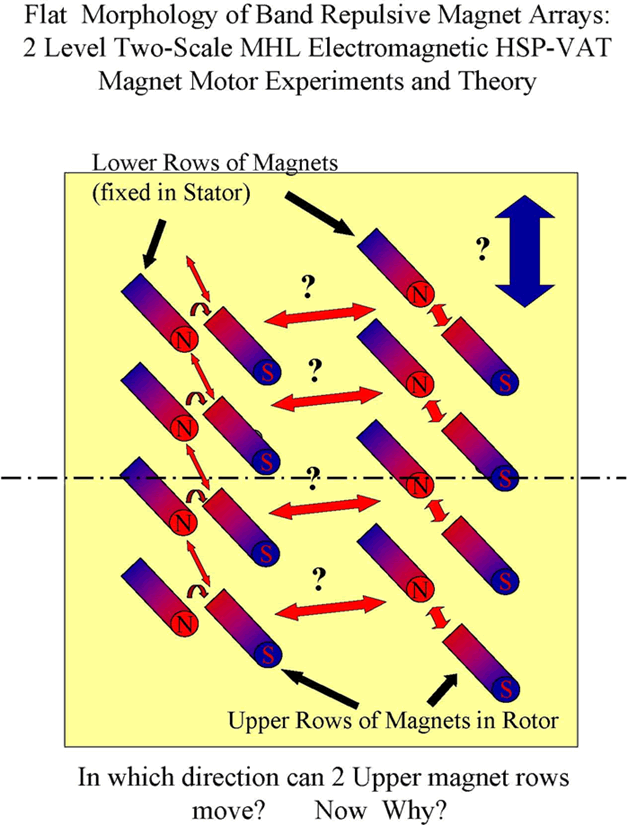
 ,
,

 ,
other EM fields and the mechanical force acting between the separate
magnets and the arrays of magnets is not linear, is not physically and
mathematically direct, straightforward, as it looks like.
,
other EM fields and the mechanical force acting between the separate
magnets and the arrays of magnets is not linear, is not physically and
mathematically direct, straightforward, as it looks like.
The Annals of Exploratory Science
Firstly, one needs to understand that the dependence, interactive function
between the magnetic fields

 ,
,

 ,
other EM fields and the mechanical force acting between the separate
magnets and the arrays of magnets is not linear, is not physically and
mathematically direct, straightforward, as it looks like.
,
other EM fields and the mechanical force acting between the separate
magnets and the arrays of magnets is not linear, is not physically and
mathematically direct, straightforward, as it looks like.
Strictly speaking - it is not understood and having a correct theory even within the homogeneous one scale MHL electrodynamics.
Here we will shortly write on the misinterpreted, mislead MM design's features just within the brackets of homogeneous one scale MHL electrodynamics. While, and this is greatly important - everyone needs to remember that any MM design is a polyscale physical environment, matter, physical model.
Because the more or less full physically based polyscale description, theory and modeling of MM is the outstanding task in terms of amount of work, intellectual development, we will be concerned with only a few points here in this analysis.
The points are that no one other physical approach, theory, but of HSP-VAT can use or describe this matter of MM function modeling. As examples we can refer to the already developed and to some degree studied the polyscale phenomena and problems given in our
"Semiconductor Coolers" - http://travkin-hspt.com/thermph/SCoolers/071.htm
1.1) One might ask the question: Why the symmetric design as the one below of one attractive or repulsive magnet over an array of identical magnets on the surface below the first one does not work for a linear consistent movement of movable upper magnet?

1.2) What's about the bottom (next) 2D design in the above drawing?
When the bottom magnets are of a linear dependable magnetic strength (in dimensionless related values)?
1.3) What's about this V-gate flat design below?

Why this morphology works within some spatial limits is almost clear. Anyway its function is based on averaged magnetic fields.
Well, nobody should object the notion that all these magnet morphologies are working not by Pair magnets, but all the magnets in an arrays are participating in the mean field distribution of magnetic field including and the upper row magnet(s) (here is given the one magnet only for simplicity of understanding)?
1.4) What's about the next 3D Magnets Bands design below? Why we compare the two bands? And What is the Averaged magnetic field? In magnets? In air? In supports?

Can not answer? Well, then it's probably you better turn yourself, instead of MM design - to improving your background and less listening to the university electrodynamics courses. Because they can not answer also. Oh, they might raise the voice and try to make some irrelevant explanation - similar to that the electron (point-mass?) is circling around the nucleus in a cloud? What cloud, now the servers are in clouds, they are also?
2) The scale (1/4) of Perendev implementation by Sterling Allan (S.A.) of NEC is not looking as a scalable design. The scalable design means the physics variables and some constants would be scaled for ALL variables and parameters.
3) The strength of the magnets and their separation distances are questionable. Nothing was said on their calculation?
4) The shielding and the morphology design of shielding is not complied in the design by S.A.
5) The mechanism of slow approaching with the stator's parts (clams) to the rotor was designed by M.Brady specifically to start the movement (initiate the torque) of the rotor - look up more attentively to the same clip in YouTube, where Brady STARTS his MM. Sterling's MM Perendev replication has the stator sliding from a side position along of the axis. In this morphology the initial torque is the subject of special set up. For example, like of Yildiz's design in some of his replications close to idea of Perendev.
6) All other MMs, but of M.Yildiz's, including of K.Minato's MM are using more or less sophisticated electrical current support for this or that part of a function. That means that inventors openly design not a pure MM.
7) The displacement between rotor's and stator's circular (cylindrical) surfaces is very important. Also is very important the angles and the magnetic strength of the magnets, and their length.
8) The design of shielding should be provided with care - as long as it is the scalable function. It is difficult to say much more on this because readers should understand what we can say regarding the Upper scale EM fields and shield function performance even with the MHL electrodynamics.
In the S.Allan's Perendev replication design the shielding was not included? At least, not visible on pictures.
To understand the forces acting in the design, for example, we can write down below one of the first time published MHL electrodynamics equations for the Upper scale rotor's magnetic field.
To assess the averaged field

 heterogeneous medium one needs to use the HSP-VAT equation of magnetic field's
wave propagation which has been obtained using the techniques developed for
numerous fields of physics in 80-90s (see, for example, Travkin and Catton,
1998,2001a). Phase averaging gives for heterogeneous medium upper scale the
non-conductive phase (phase 1 - an air), for example, from the governing set
of equations the following Heterogeneous MHL electrodynamics (magnetic) wave
governing equation
heterogeneous medium one needs to use the HSP-VAT equation of magnetic field's
wave propagation which has been obtained using the techniques developed for
numerous fields of physics in 80-90s (see, for example, Travkin and Catton,
1998,2001a). Phase averaging gives for heterogeneous medium upper scale the
non-conductive phase (phase 1 - an air), for example, from the governing set
of equations the following Heterogeneous MHL electrodynamics (magnetic) wave
governing equation



 (1)
(1) where

 is the speed of displacement of interface surfaces and functions
is the speed of displacement of interface surfaces and functions











 are the additional surficial terms and terms closely dependable on interfaces
speed.
are the additional surficial terms and terms closely dependable on interfaces
speed.
This equation should be used instead of the Homogeneous (lower scale) MHL

 wave equation for the air phase
wave equation for the air phase
 (2)
(2)
As we can observe the whole 6 new unknown for homogeneous one-scale magnetism (physics),
magnetic fields MHL equation
terms that are present in the Upper (Magnet Motor's rotor) scale magnetic field

 equation (1).
equation (1).
9) Note, that in this above equation (1) there are present the features, terms that are of the same character for this 2-scale model of Perendev MM as that was discovered and studied for principally the same system of physical requirements and demands as for the problems in our 1990s research on polyscale transport in thermal physics and fluid mechanics, including the convective Heat Exchangers (HE) function, design and optimization.
Have you noticed that the HE shape and quality have changed throughout the last ~60 years? Younger generation could notice that even the notebooks and PC's volume and thickness' changed ? Why is that, how you think? Up to now, mostly by the trial and error design mode. The companies are not able to make the design with the scaled technologies. Too complicated. These physics (HSP-VAT) and technologies should work where the real demand and the real money can appear. The MM technology is among of that kind appealing and new fields.
The most advanced areas with the scaled physics methods have been explored in the fields of thermal physics and fluid mechanics, see our sections and other publications referred in those:
"Fluid Mechanics" - http://travkin-hspt.com/fluid/index.htm
"Thermal Physics" - http://travkin-hspt.com/thermph/index.htm
"Heat Exchangers. It is the Hierarchical ↑↓ Technology" - http://travkin-hspt.com/thermph/07.htm
"Semiconductor Coolers" - http://travkin-hspt.com/thermph/SCoolers/071.htm
The partial list of the same results on analysis of MM theory and modeling can be drawn almost the same as for HE.
We should state the same kind of conclusions for the MM modeling and design as was formulated near 15 years ago on Heat Exchangers design. They have the same kind of philosophy in theory, design and modeling.
The analysis drawn for the MM design specifics should be added with the comments on the DMM-DNM results of the two-scale HE simulation, as the following:
1) The obtained parameters of performance should be vector functions (while for magnetic 2-scale interaction could be of tensorial character), not scalar variables common in homogeneous theory of MHL evaluation. This distinction add a lot in understanding of the performance of the EM fields and force interactions for MM as a vector (tensor) processes (directional).
2) Vectorial components of the energy transport in such geometries of MM as Perendev and Yildiz's models can reach substantial proportions of force interaction.
3) There are additional physical phenomena which physically known, but can not be observed in the modeling through the one-scale homogeneous MHL models - well, those models are of nil quantity at present. Those are - a) the transport of energy due to fluctuation of fields in the device - "dispersive" transport component; b) the transport component due to surficial transport of EM fields (and energy) - "interface" transport components.
4) These new components of the bulk energy transport are also the vector components.
Among the important and unusual results obtained with the two scale HSP-VAT formulation of the magnetic motors as MM-M2Sc mathematical models and their optimization those that concern to and reflect the performance of the MM with dependency on morphological parameters, as specific surface, phase fractions and other morphological volume and surface specific terms and data. In Yildiz's MM these features are numerous - designer was in a search throughout the years.
The scaled HSP-VAT formulation allows one to include and highlight physical phenomena that are not observable when conventional homogeneous modeling is used.
We should to re-iterate the conclusion of the 90s:
There exists no way to find out, to control or/and to optimize the performance of the two- or three scale MM while using the only Lower Scale governing equations.
10) A definite volume of HSP-VAT Ht Electrodynamics is given in our websites:
"Electrodynamics" - http://travkin-hspt.com/eldyn/index.htm
"Particle Physics - Heterogeneous Polyscale Collectively Interactive" - http://travkin-hspt.com/parphys/index.htm
11) 03/28/2013 (Th) - And today Sterling D. Allan uploaded the interesting fact on another working MM of Perendev style - http://peswiki.com/index.php/Directory:Michael_MacInnes%27_Magnet_Motor
At present we would comment that this MM design is pretty close to the Perendev of M.Brady by Sterling construction. The stator of M.MacInnes,' A.Abyaneh's MM is not filled up completely by magnets - that is, probably, of the two reasons:
1) is that the magnets in this MM became degraded and are needed to be re-saturated (inventors say); that means the cost and the "re-saturation" system;
2) the arrangement of magnets in stator was sought by experimentation - and we can watch the result of free placement of magnets in stator.
This is the possible reason why the MM by M.MacInnes' is starting - the magnets need to be in a special 3D interaction for the torque to appear.
The power of the motor is seems in the low range so far.
The point that this inventor is bragging on some features that could be superior to the Yildiz's MMs it's just the bragging only. Yildiz's MMs have, at least, the two-three technical advances that this MM by M.MacInnes' and partner is a way behind of.
